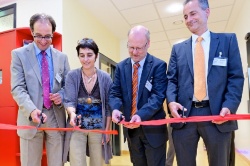Hospital in a lab
The new Hospital Engineering Lab in Duisburg, Germany, which was officially opened in July by Barbara Steffens, Health Minister for the German federal state, is a project of four Fraunhofer Institutes.


They partner with more than 80 institutions from industry, networking societies and researchers, to give users, manufacturers and scientists the opportunity to simulate different hospital-related scenarios under real-time-conditions and measure their effects – in terms of costs and quality care. The Fraunhofer Institutes partner with more than 80 institutions from industry, networking societies and researchers, to give users, manufacturers and scientists the opportunity to simulate different hospital-related scenarios under real-time-conditions and measure their effects – in terms of costs and quality care.
Well-meant is not always well done – this is also true of innovations in healthcare intending to improve quality in care and to optimise standard processes in hospitals. Often enough new products function fine in their own right but do not have any impact on workflow optimisation because they fail to interact with patients or medical staff, existing and established technologies or procedures. The result: Hospitals and healthcare systems are burdened with costs for new investments that bring no financial release in daily business due to improvement of care in return.
Facing a situation in Germany, where every fifth hospital is in the red, this turns out to be an existential problem for hospitals. On the other hand, companies rarely have ‘real-life conditions’ in which to test their products practically before rolling them out into the market. The Hospital Engineering Lab was established in Duisburg to break through this no-win situation for both parties.
Spread over about 350 square metres, the new lab offers a replica of all relevant hospital areas – operating theatre, rooms for patients, nurses and doctors, as well as supplying and functional units. ‘The idea was to set up an environment that helps us to act out hospital processes in different scenarios, adapt experiences from hospitals and modify strategies and technologies in a team. We aim to avoid unnecessary costs and improve quality of care and efficiency by developing intelligent and user-driven technologies,’ explained Dr Wolfgang Deiters, Assistant Director at Fraunhofer ISST in Duisburg (ISST=Institute for Software- and System Technology), which hosts the new lab.
Within this process the first, and maybe most important, realisation is that intelligent does not always mean highly sophisticated as one striking example shows, and noted in Barbara Steffens opening speech. A hospital that invested in new telephone equipment for patient rooms was suddenly faced with many more calls for nurses. The simple reason: older or even dementia patients could no longer operate the high-tech telephones and needed assistance for every call they wanted to make. Consequently, the hospital was doubly stressed – by the investment for the new equipment and by additional work for staff.
To analyse daily business processes such as this, the Hospital Engineering Lab is equipped with solutions and products of around 60 vendors – ranging from hygiene dispensers to energy supply solutions. These products are tested separately, as well as in combination with the rest of the equipment and within the working process.
Remaining a work in progress
In doing so, companies and users can be sure of rolling-out practical solutions with deep impact on the performance of a hospital – in a positive way, of course. The Hospital Engineering Lab is not planned to be completely finished on any particular day; on the contrary, it is designed to re-invent itself continuously by hosting and testing new products and processes regularly. So far, several highlight issues have evolved, for example sensor-based assistance systems. By recognising a patient and optimising the environment accordingly or sounding an alarm – e.g. in the bathroom – these solutions have the potential to optimise comfort and safety for the patients. Another topic is the use of RFID technology, like labels, to survey and document numerous procedures in the operating theatre or elsewhere.
A huge issue in every hospital are the logistics of purchasing and distributing materials and pharmaceuticals. What is needed when, where and in what amount? Answers to these questions are also worked out in the lab. As one of the biggest cost drivers, energy supply is, of course, another issue. At the moment it is testing how an individually regulated wattage can decrease costs by need-based acclimatisation of rooms.
Last but not least, technology not only has the potential to boost recovery directly but also, in an indirect way, by creating an environment in which the patient feels comfortable. That is why things such as light concepts are also a strong focus, along with ways to improve personal care by creating more time for staff to spend with a patient.
Altogether, walking through the lab gives you an idea of a bright future of care – both for hospitals and patients. Whether or not this small ‘lab-world’ becomes a reality one day, or only remains as a nice try, is the something that cannot be simulated so far.
05.09.2013










